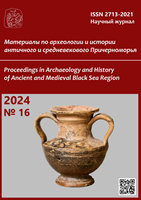Золотые подвески в форме львиных головок из погребений последней четверти V в. до н.э. некрополей Таманского полуострова
Gold pendants in the form of lion heads from the burials of the last quarter of the 5th century BCE of the necropoleis of the Taman Peninsula
Author(s): Mikhail TREISTER, Nikolai I. SudarevSubject(s): Archaeology, Visual Arts, Cultural Anthropology / Ethnology, Prehistory
Published by: Нижневартовский государственный университет
Keywords: North Pontic area; Bosporan Kingdom; Taman peninsula; Olbia; gold pendants in the form of heads of lions; bulls and rams; black-glazed pottery; dating of the burial complexes;
Summary/Abstract: This paper focuses on the publication of gold pendants in the form of lion heads of the 5th century BCE from the necropoleis of the Taman Peninsula. The pendants in question are the most common type of gold pendants in the form of animal heads, which are also represented by pendants in the form of bull and ram heads. The published pendants of all three groups are presented in the form of a short catalogue in Appendices 1—3. These pendants were widespread from Southern Italy and Sicily in the West, to Rhodes, Euboea, Macedonia, Thasos and Thrace, to Olbia and the Bosporus, as well as the Kuban region, in the East. The attention that is attracted by the finds from the Taman Peninsula is explained by the fact that they all come from excavations of necropoleis, from the burial complexes that can be reliably dated by the black-glazed pottery. Probably the earliest find is from the necropolis of Eretria, if the dating of the complex to the first quarter of the 5th century BCE is correct. It is obvious that pendants in the form of bull and ram heads also appeared at the same time, judging by their use as elements of necklaces from the burials of the same cemetery. In the North Pontic region, the earliest pendant in the form of a lion’s head is a find from the grave no. 10/1913 of the necropolis of Olbia, which may date back to the second, or rather the third quarter of the 5th century BCE. The pendants from the complexes of the Taman Peninsula, presented in the paper, can be dated to the last quarter of the same century and even to the turn of the 5th — 4th centuries BCE. In the late 5th century BCE, such pendants appeared in Tarentum, where they became widespread in the following century.
Journal: Материалы по археологии и истории античного и средневекового Причерноморья
- Issue Year: 2024
- Issue No: 16
- Page Range: 194-233
- Page Count: 40
- Language: Russian

